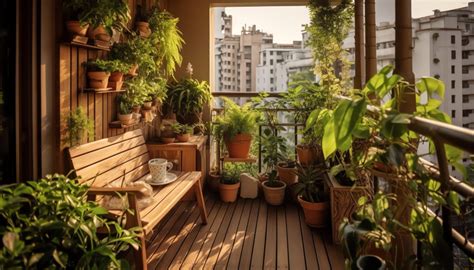Maximizing Light Exposure for Thriving Balcony Plants: Expert Gardening Tips
Having a balcony is a perfect way to enjoy a personal green space, even in urban environments. But one of the major challenges balcony gardeners face is ensuring their plants get enough light. Maximizing light exposure is essential for healthy plant growth, and this article will explore strategies, tips, and best practices to help you create a thriving balcony garden, regardless of space or location. Whether you’re a beginner or an experienced gardener, these insights will help you master plant selection, care, and design to optimize light conditions and ensure lush, vibrant growth.
Key Concepts: Understanding Light Requirements for Balcony Plants
Maximizing light for balcony plants begins with understanding their light requirements. Different plants have varying needs, ranging from full sun (at least 6 hours of direct sunlight) to partial shade (about 3-6 hours of indirect light).
- Direct sunlight: Ideal for sun-loving plants like tomatoes, peppers, and succulents.
- Indirect light: Suitable for plants like ferns, begonias, and herbs.
- Partial shade: Works for shade-tolerant plants such as hostas and impatiens.
Understanding these requirements helps you select the right plants for your specific balcony conditions. Additionally, some balconies face light limitations due to orientation, surrounding buildings, or structural obstructions, making it crucial to plan for maximum light exposure.
Historical Context: Evolution of Urban Gardening
Urban gardening has a long history that stretches back to ancient civilizations, where rooftop gardens were cultivated to make the most of limited space. Today, with more people living in apartments and urban settings, balcony gardening has become increasingly popular. As cities grow more densely populated, innovative strategies for optimizing plant light exposure have emerged, allowing urban gardeners to continue growing food, herbs, and ornamental plants in restricted spaces.
Current State Analysis: Light Challenges in Balcony Gardening
Balconies often present unique lighting challenges due to their orientation and location. North-facing balconies receive minimal direct sunlight, while south-facing ones are flooded with light. East and west-facing balconies experience shorter periods of sunlight. In densely built areas, buildings can cast shadows that further limit available light. These challenges make it essential to employ effective strategies to ensure your balcony plants receive the necessary light for growth.
Key Factors Affecting Balcony Light:
- Balcony orientation: North-facing balconies are the most challenging, as they receive the least direct sunlight.
- Surrounding buildings: Tall structures can obstruct sunlight for extended periods, creating shade.
- Seasonal variations: Light intensity and duration change throughout the year, with shorter days in winter.
Understanding these factors allows you to tailor your approach to maximizing light, whether by choosing sun-loving plants for a south-facing balcony or using reflective surfaces to enhance indirect light on a north-facing one.
Practical Applications: Maximizing Light for Optimal Plant Growth
To overcome lighting challenges on your balcony, consider the following practical solutions:
- Choose light-friendly plants: Opt for plants that can thrive in your balcony’s lighting conditions. For low-light balconies, select shade-tolerant plants, while sun-loving plants can flourish on sunny balconies.
- Use reflective surfaces: Mirrors or reflective panels can help bounce light onto shaded areas, increasing the amount of sunlight your plants receive.
- Install plant shelves: Vertical gardening with plant shelves allows you to position plants at different heights, ensuring they all receive sufficient light.
- Rotate plants: Regularly rotating your plants ensures they get even light exposure on all sides, preventing uneven growth.
- Use grow lights: For balconies with insufficient natural light, grow lights can supplement sunlight, promoting healthy growth even in shaded areas.
Case Studies: Real-World Success Stories
Here are some examples of successful balcony gardening approaches from different types of balconies:
| Balcony Type | Plant Type | Light Challenges | Solution Implemented |
|---|---|---|---|
| North-facing | Herbs and ferns | Limited direct sunlight | Used reflective surfaces to enhance indirect light |
| South-facing | Tomatoes and succulents | Excessive sunlight and heat | Installed shade cloth to reduce light intensity |
| East-facing | Ornamental flowers | Partial morning sun | Maximized morning light and added grow lights for afternoon shade |
Stakeholder Analysis: Understanding Diverse Needs
Balcony gardening involves multiple stakeholders with varying priorities:
- Homeowners: Want to maximize space and grow aesthetically pleasing or edible plants.
- Urban developers: Focus on sustainable building designs that incorporate greenery, including balcony gardens.
- Plant nurseries: Provide suitable plants and materials, advising customers on the best choices for limited light exposure.
Implementation Guidelines: Step-by-Step Process
To successfully maximize light exposure on your balcony, follow these steps:
- Assess your balcony’s light conditions: Determine how much direct and indirect light your balcony receives daily.
- Select appropriate plants: Choose plants based on your balcony’s light conditions, ensuring they match your environment.
- Optimize light access: Use reflective surfaces, rotate plants, and install shelves to maximize sunlight exposure.
- Use supplemental lighting: Install grow lights if natural light is insufficient for healthy plant growth.
- Monitor plant health: Regularly check for signs of light stress (e.g., yellowing leaves or leggy growth) and adjust your setup as needed.
Ethical Considerations: Sustainability and Resource Usage
While maximizing light for balcony plants, it’s important to consider the environmental impact. For example, installing grow lights increases electricity consumption. Therefore, it’s essential to choose energy-efficient lighting solutions like LED grow lights. Additionally, reflective surfaces can sometimes pose a risk to birds, so be mindful of how you position them to avoid unintended harm.
Limitations and Future Research
Despite the various strategies for maximizing light exposure, certain limitations remain. Balconies in high-density urban areas may still struggle to receive adequate sunlight due to permanent structural shading. In these cases, further research into more efficient grow light technologies and innovative urban gardening designs is needed. Future studies could also explore the impact of seasonal variations and climate change on balcony gardening in different geographic regions.
Expert Commentary
Maximizing light for balcony plants is a challenge that requires creative solutions and a deep understanding of plant needs. According to leading horticulturists, the best approach combines careful plant selection, innovative use of space, and technological advancements like grow lights. While there’s no one-size-fits-all solution, balcony gardeners who tailor their strategies to their unique environment will find success. By balancing sustainability with practicality, urban gardeners can create thriving green spaces, even in the most challenging conditions.


